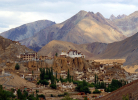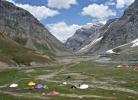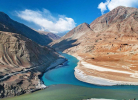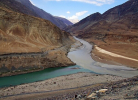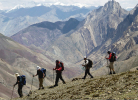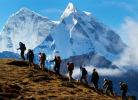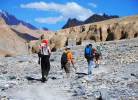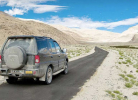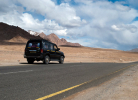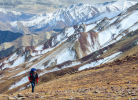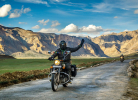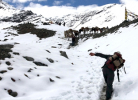Culture Of Ladakh
To the south of Himalayas, this Tibetan plateau stands at a height of 3000 -5,753 meters. This region is called the land of high passes and it holds the world’s top three tallest mountain passes, which can be scaled on a vehicle. Stuck between mountains and barren landscape, this valley is lush with vegetation and culture.
People have created a beautiful community using the ingenious resources as their basic requirements. Young help the old and the old teach the young. There is always a unity among people, even in this unique environment with scarce resource. Do you want to know more about the culture of Ladakh and see what makes peace possible in this geographically isolated area?
History Of Ladakh
The first recorded inhabitant of this region was the Brokpas, who populated the lower part of the Indus Valley. Ladakh’s first occupants were Dards, an immigrant community from Tibet and nearby regions. Their culture and lifestyle were in coherence with the early inhabitants.
In the 10th century, Skit de Nemagon, Tibet King invaded Ladakh and defeated all the principalities. He formed a capital in Shey and Ladakh became an independent country. During this time, many monasteries were built and political developments took place.
The Namgyal reign started in the 16th century and was able to resist the Islamic invaders. Many gompas were destroyed during the invasion and a marriage treaty was formed for peace. In the 19th century, the Sikh rule started in the surrounding region. Ladakh was captured by Dogras and the famous Sino-Sikh war took place. In 1947, Ladakh became a part of India and came under the capital of Srinagar. By the later mid of 20th century, Tibetan refugees started to pour into Ladakh. In 2019, Ladakh became a union territory.
Languages Of Ladakh
The official language of Ladakh is Ladakhi. It is also called Bodhi, which is a Tibetic styled language. There are different dialects of Ladakhi like Lehsat, and Stotskat. Nubra is common in the northern regions. The Ladakhi language has Tibetan script.
Facts Of Ladakh
- Ladakh is the highest settlement in the country (in terms of altitude).
- This is the only place in India to find the Bactrian camel – the camel with two humps.
- The highest salt lake in the country is in Ladakh – Pangong Lake. Even though it is a salt lake, it completely freezes in the winter.
- One of the highest astronomical centers in the world is found in Ladakh (third in the world).
- The top three highest mountain passes with vehicle routes are found in Ladakh.
- The highest bridge in India is Bailey bridge of Ladakh
- This ice desert is home to more than 225 bird species and many migratory birds visit Ladakh
- One of the top ten hardest trekking trails of the world is found in Ladakh – Chadar trek. This route is formed over a frozen lake
Religion Of Ladakh
For many centuries together, Ladakh has been isolated from the rest of the societies due to geographical and climatic conditions. Thus, the ancient Tibetan style of religion is still preserved. 77% of Ladakhis are Buddhists. 8% of the population follows Hinduism and 14% follow Islam. There are a few communities who follow Sikhism and Christianity.
Arts
Painting
The most iconic painting of all is the Thangka painting made by Buddhist monks. This painting is done on silk or cotton cloth and is embroidered. This painting is made with religious themes only and you can find many monasteries sporting very large such paintings. It is one of the unique and expensive souvenirs that are famous among tourists. The wall paintings are found in the monasteries and temples, which are made with the Secco technique. It is one of the oldest styles of painting in Ladakh.
Dance
The dance of Lamas or the Monk Dance is the iconic attraction of the land. People visit Ladakh to take part in the festivals to watch this tantric styled dance. The best festival of all to enjoy is the masked monk dance of Losar, the local New Year.
Find here other dances of the region are:
- Jabro dance – dance of Tibetan nomadic people. This is a festive dance with Darnianmusic (a local style of guitar) and flute.
- Drugpa-Rchese – this dance is the style of the local art of Aryans. The dancers groom themselves with silver ornaments and flowers. Surnaand Damman is used for creating music for this style of dance.
- Yak dance – this is a duo dance of two men with rhythmic movements under a yak skin. They represent the animal. A milkmaid comes to tame the yak, but the yak stays stubborn. Then, the milkman comes with the lash to control it. This is the theme of this dance.
- Tukhatanmo – this is a seasonal dance performed during the blooming season in Nubra valley and surrounding regions.
- Bagstonrches – marriage dance with Damman and surna music.
- Shon dance – royal patronage dance.
- Surahi dance – dancers carry pots on their heads while dancing – almost extinct now.
- Kosan dance – dance is performed while riding on a horse.
Music
Ladakhi music is similar to Tibetan music with instruments like damman, surna, and others. Some of the religious music forms have Sanskrit or Tibetan chanting. Yang chanting is one of the famous types of such religious music styles.
Literature
The first ever literature festival of Ladakh took place in 2019. The traditional literature works are found in the classical Bhoti language.Folklore
Pan-Tibetan epic is taught from generation to generation. This epic portraits a heaven sent king. The Gesar epic revolves around song, dance, and drama that explain a superhuman figure, who overcomes bad elements and help humans with magic, martial power, and strength. In the past, the priests, singers and storytellers were the ones who protected the legends. They passed on legends and lore by singing riddles and religious stories.
Festivals Of Ladakh
The most iconic festival of all is the Losar festival or the local New Year. Apart from this, the other top festivals to enjoy are:
- Sindhu Darsha – June
- Hemis festival – July
- Saka Dawa festival - June
- Ladakh festival – September
- YuruKabgyat – July
- TakTok Festival – July
- PhyangTsedup – July or August
- ThikseyGustor – each monastery has a different date for this festival
- Dosmoche – February
- MathoNagrang – March
- Stok Guru Tsechu – February or March
Clothing
Men wear Goucha, a woolen robe, which can be fastened at the neck. Around the waist, they wear skerag, a sash. Women wear kuntop, which is a similar woolen robe. They wear a shawl, which they use to carry parcel or babies. Their traditional attire is very colorful. Yak skin and goatskin are common material for clothing. Peraks, a top hat is worn to indicate the rank of the family. When the owner of the hat dies, the hat is passed on to the younger generation. They wear shoes made of yak leather and hair.
Cuisines
The cuisine of Ladakh is inspired from Tibet. Top dishes served in Ladakh are Thupka noodles, Ladakhi pulao, Tigmo, Khambir, saag, butter tea, phirni, skew, momos, kulcha bun, Cholak, and others.
Crafts
Weaving is an important cultural aspect of the land. Carpet and textiles of Ladakh are quite famous among tourists too. Other top craft works of the region are embroidery, wood carving, pottery making, basket making, stone carving, hand knitting, dragon painting, clay sculpturing, silverwork, and others.
Adventure Activities
Ladakh is the land for adventure activities. Top activities to enjoy here are:
- Mountain biking
- Trekking – Chadar trek, Markha valley trek, Stok Kangri trek, and others
- Camping
- Water rafting
- Camel safari and jeep safari
- Mountaineering
- Ice hockey
- Quad biking
Occupation
Ladakh is majorly an agrarian society. In 1960s, Ladakh was connected with the rest of the world by the road that runs between Ladakh and Kashmir Valley. In 1974, foreigners started to pour in. Thus, a part of locals became guides of the tourists. With foreigners, the western culture infused into the land. Young are now migrating to Leh for a better earning and lifestyle.
Ladakh Tourism
Ladakh is an important adventure and spiritual destination to cover in India. The place is famous for adventure activities, monasteries, cuisine, panoramic view, and natural wealth. Top places to visit in Ladakh are Pangong Lake, Magnetic Hill, Chadar Trek, Leh Palace, Hemis national park, Tso Moriri, Zanskar Valley, Shanti Stupa, Phuktal monastery, Kardung La pass, NamgyalTsemo, Nubra Valley, and others.


